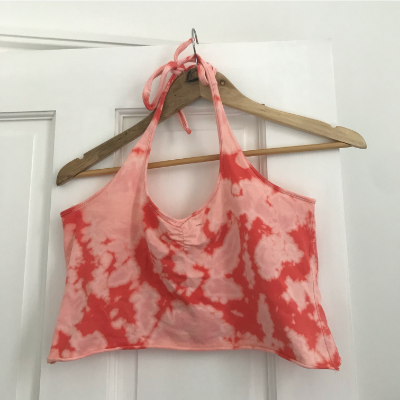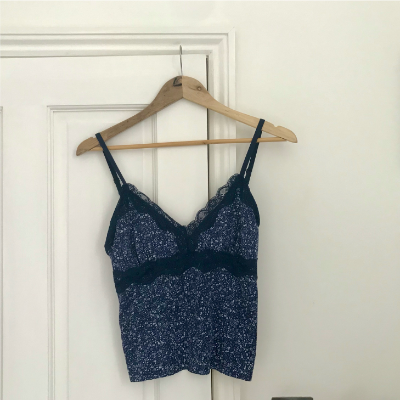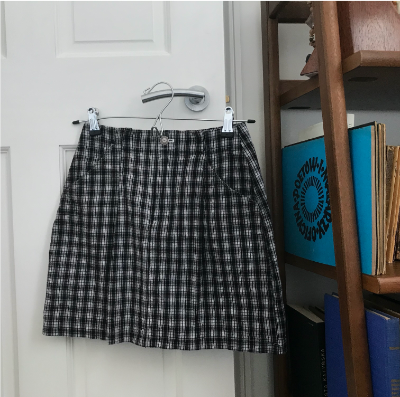A month into lockdown, I found myself curing my boredom by browsing clothes online and inevitably buying outfits for occasions I wouldn’t celebrate. Safe to say Parkend Wednesdays will not be on the cards in Michaelmas, and a ‘Great British’ summer will probably not materialise either. Two months into lockdown, I decided that it was time to finally tackle my bedroom.
A common cliché is ‘tidy house, tidy mind’; with that attitude, I opened my wardrobe. Sifting through it unearthed some too-small treasures of years gone by, shoved into the back of a cupboard and forgotten. Other discoveries were less promising; I’m sure many will relate to the fact that despite your mother’s bold claims that ‘the dress looks lovely’, the dress, in fact, did not look lovely. For someone with a distinct lack of practical skills, the mission to transform these finds into something I might actually wear felt a little bit daunting. But I cracked on with it; if people were making a small fortune on Depop and Etsy (occasionally funded by me) by selling vintage and up-cycled clothes, I might as well try doing it for myself on a budget.

Definitely my artsiest moment; this was so easy, just mix one-part bleach to one-part water, roll up the top and pour over the bits you want to bleach. 
Very much a five-minute job of measuring the length of top I wanted and cutting it – now I have lots of spare fabric to work with, as yet unplanned!
The phrase ‘arts and crafts’ brings back distinct memories of primary school, tiny red-handled safety scissors and glitter just about everywhere except the page. Equally, the thought of making or altering a piece of clothing start to finish felt like something that my (far more talented) grandma would always do in front of the telly and distinctly unattainable to one girl armed with just some questionable garments and no sewing machine. Nevertheless, I got a needle and thread out and went for it. Taking a pair of scissors to a pair of trousers you remember costing you a certain number of hours of work could have ended in disaster… but, it didn’t. Proud at myself for succeeding at something (admittedly very simple) I’d never done before – altering an item of clothing I no longer wore into something I liked once again – I decided I would take this time to teach myself to do more.
I’ve hardly reached great heights of creativity, but I’ve made things I’d abandoned fit me again and created unique items. Tiny tasks like turning a skirt from a low-waisted one to a high-waisted one with a few stitches, or re-hemming trousers to make them more flattering would not have occurred to me a few months ago, especially with forgotten clothes that I’d already dismissed as unfashionable. In braver moments, I managed to transform a skirt that however much I tried couldn’t make fit properly into a top, a far too big dress into a top.
On one especially quiet afternoon, I threw caution to the wind and decided that tie-dyeing, inspired by something I’d seen on social media seemed like a great idea. Simply by cropping, hemming and taking in various items, it feels like I’ve gone out and bought a whole new piece of clothing. Lockdown has given me the opportunity to do stuff which really isn’t radical, but equally requires confidence and time to do.
Finding potential in things that I’d let hang in my wardrobe made me realise how guilty I can be of commodifying fashion. Even while I make an effort to buy second-hand, the closure of shops in lockdown makes this a lot harder. Looking at what I already have and finding forgotten items is making me consider how much of my wardrobe I actually wear. So many of us are guilty of not wearing things to their full potential and buying new things instead because of their rapid availability and low cost. By sitting down to alter an item of clothing, even in a completely amateurish way, you realise how much work goes into making something really simple, and question how the prices of fast fashion can possibly be justified.

I’d always really liked this skirt but it was too big. I thought about turning it from an A-line into a pencil skirt by taking it in at the waist, but instead put pleats at the front to make it fit 
Originally a skirt I’d bought on Depop, I decided the material would make a really pretty night out top. Wouldn’t advise looking too closely at my sewing but I’m excited to wear it!
According to a report on the fashion industry from consumer analyst Hitwise, fast fashion from leading retailers, especially those online, such as Shein, Nasty Gal, Missguided and PrettyLittleThing, account for 66% of all traffic in the fashion industry. Last summer, Missguided was advertising a ‘miracle’ £1 bikini, a product that simply couldn’t be justified as paying a minimum let alone living wage. Whilst the ethics of fast fashion are often focused on things such as the carbon footprint of a piece of mass-produced clothing, the Coronavirus crisis and investigations into social distancing in the industry have shed a spotlight on the conditions inside factories. As seen with Leicester’s Boohoo factory in recent weeks (a city just coming out of a localised lockdown), an undercover reporter at the Sunday Times reported that workers could be expected to receive just £3.50 an hour in unsafe, overcrowded conditions, a fact that Boohoo has been unwilling to confirm. The Independent’s Lauren Bravo reported that according to The Lowest Wage Challenge, globally less than 2% of people who make clothes for companies whose selling point is a low cost earn a living wage, a fact often skirted around by companies who justify this by paying the local minimum wage, a very different thing to the actual living wage.
It is so easy in lockdown to spend money you might have spent out and about in normal life on new clothes. The websites for brands such as Topshop and Asos have been flooded in the past few months with editorials on lockdown dressing, with branding using the pandemic to market everything from loungewear to workout clothes for 9 am with Joe Wicks and ‘night-in’ outfits. The availability of fast fashion at the push of a button is trapping us in a cycle of buying and disposing of clothes far too regularly. With all the time we now have at home, let’s use it to consider how we can have a more sustainable attitude to how we dress, and even (dare I say it) give making your own a more modern and slightly cooler rep.
All images by Sophie Wright.





